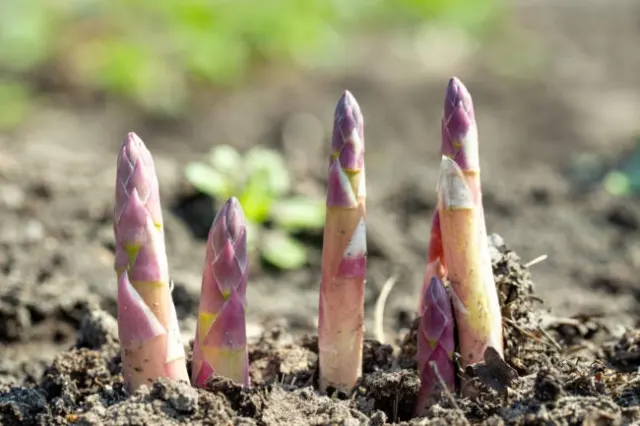With all the seed buying and gardening that happens in spring, people forget that there are perennial vegetables that grow back on their own. Here are the vegetables you can plant once and enjoy year after year!

Part of the gardener’s spring ritual is ordering seeds or buying starts of favorite vegetables like tomatoes, peppers and cucumbers. But did you know that there are perennial vegetables that you can plant once and enjoy for years to come?
You can probably guess a few of the vegetables on our list, but others will surprise you.
Artichokes
Both Jerusalem artichokes (sunchokes) and globe artichokes are excellent options, often growing very well in a range of conditions. The related cardoons and Maximilian sunflowers are other options in this group to consider.
Asparagus
Asparagus is definitely one of the best-known and most widely grown perennial vegetables. It can grow in beds alongside other perennial plants, or even in annual vegetable beds. Spring is a good time to think about planting asparagus crowns. They will not provide a yield right away but will provide dividends in the years to come.
Sorrel
Sorrel is a perennial herb with tart, lemon-flavored leaves used for soups, stews, salads, and sauces. The two main sorrels grown are common sorrel, Rumex acetosa, and French sorrel, Rumex scutatus. They are relatives of rhubarb, and the leaves contain small amounts of oxalic acid that’s not harmful when consumed in small quantities, (unless you are sensitive to oxalates).
Sorrel tastes best in early spring; it becomes bitter as the weather warms. It’s a delicacy that is hard to find in markets because it wilts shortly after harvest. Garden sorrel is hardy to Zone 5; French sorrel is hardy to Zone 6.
Horseradish
The taste of freshly grated horseradish root is so intense and flavorful—once you taste it you’ll never want to go back to the bottled stuff again. Fortunately, horseradish is easy to grow at home, suitable for growing Zones 3-9. Plant the roots early in the spring in a sunny location with room for the roots to spread. The plant grows to about 18 inches in height with tall, curly-edged leaves. The roots can be harvested in the fall and early winter.
Rhubarb
Although its tart, red-tinged stalks generally are used as a fruit in pies and other desserts, rhubarb technically is a perennial vegetable in USDA Zones 4 through 7. Like asparagus, it most often grows from purchased roots and can take a few years to begin producing well.
Mature plants will provide thick stalks to harvest for one to two months during spring, after which those plants should be allowed to grow uncut. Keep in mind that their large leaves are toxic and the oxalic acid present in their stalks might be harmful to people with some health conditions.
Chives
Chives are, however, sold at markets and stores. The question is: how fresh are they by the time they make it to your table?
Isn’t it ultimately better to step outside, harvest a small bunch, chop them up and add them to salads and dips – all in a matter of minutes? Plus, there are lots of brilliant uses for chives and their blossoms.
You’ll be pleased to know that chives are very hardy. Such vigorous growers in fact, that they will need dividing every few years.
Garlic
Many think of garlic as an annual because gardeners tend to harvest the entire crop of bulbs, requiring that more be planted for the next year. However, gardeners who get in the habit of leaving a portion of their bulbs in the ground are rewarded with garlic that comes back every year. This involves harvesting garlic from larger plants while letting smaller plants die back and stay in the ground.
Garlic generally falls into two categories: softneck that do better in warmer areas and hardneck that grow well in colder climates. Hardneck garlic plants also produce garlic scapes—the long, curling stems that can be snipped off and enjoyed for their mild onion-garlic flavor.
Daylilies
Daylilies are a great value vegetable. These plants offer a number of edible yields. Every part of the plant — from the tubers to the shoots to the blooms — is edible and each part has a range of different uses. The flowers, in particular, are considered to be a delicacy.
Watercress
Speaking of spicy, one of the peppery perennial greens, watercress—as its name implies—likes to grow in shallow water in USDA zones 3 through 11. That preferably should be clean, moving water such as what flows in a creek. Usually started from either cuttings or seeds, it is at its best during the cooler months and should be harvested while still young, since it loses much of its bite after it blooms.
Kale
Kale is a hardy annual with a short time to harvest.
The real beauty lies in the fact that you can harvest leaves until the first frosts hit and the snowflakes fly.
Technically, kale is a biennial, yet it is treated like an annual. However, it can also be a perennial, depending on how you stretch your reality.
If you leave it in the garden over winter, covered with mulch, it will begin to regrow in early spring, sending up new shoots and leaves. Again, it takes a no-dig approach, so make sure to plan your garden accordingly.














